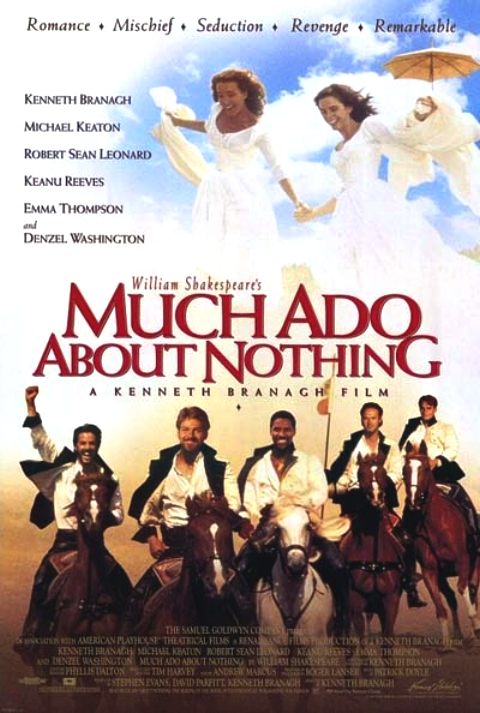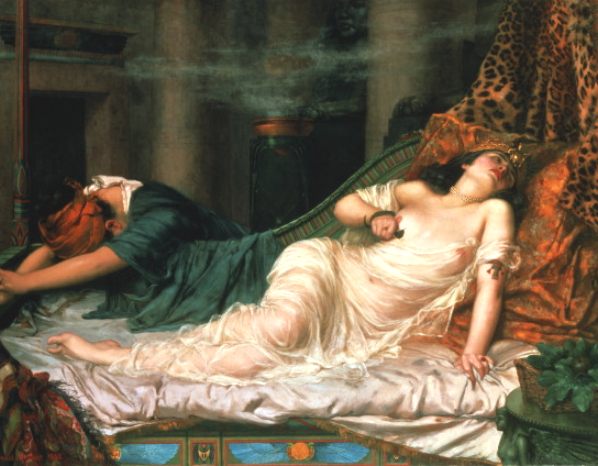|
These
are considered by many to be the most popular plays of the Bard.
COMEDIES:
-
A
Midsummer Night's Dream
-
As
You Like It
-
Much
Ado About Nothing
-
The
Merchant of Venice
-
The
Taming of the Shrew
A Midsummer Night's Dream (1595)
First official record: Francis Meres' Palladis Tamia (1598)
First published: in quarto in November or December 1600
As You Like It (1599–1600)
First official record: on 4 August 1600 a staying order was entered in the Stationers' Register for As yo like
yt.
First published: First Folio (1623).
First recorded performance: possibly on 2 December 1603 at Wilton House in Wiltshire, where a play was performed for James
I; earliest definite performance on 20 December 1740, at Drury Lane.

Much Ado About Nothing (1598–1599)
First official record: version of the play published in 1600 (this play was never entered into the Stationers' Register).
First published: Much adoe about Nothing was published in quarto in 1600.
First recorded performance: 14 February 1613, performed at court as part of the festivities to celebrate the marriage of Princess Elizabeth of Bohemia and Frederick V, Elector Palatine
Evidence: The play was not included in Francis Meres' Palladis Tamia, which was registered on 7 September 1598, suggesting it hadn't been performed prior to that date. Furthermore, evidence in the quarto text suggests that Shakespeare originally wrote the role of Dogberry for William
Kempe, however, records indicate that Kempe left the Lord Chamberlain's Men sometime in late 1598, so the play must have been written before then. As such, it was most likely composed sometime in the latter half of 1598 and was certainly completed before the new
year.

The Merchant of Venice (1596)
First official record: version of the play entered into the Stationers' Register on 22 July 1598
First published: version of the play published in quarto in 1598 as The most excellent historie of the merchant of Venice. With the extreame crueltie of Shylocke the Jewe towards the sayd merchant, in cutting a just pound of his flesh: and the obtayning of Portia by the choyse of three chests
First recorded performance: the play was performed at court for King James on 10 February
1605.
Evidence: The play was obviously in existence by 1598, however, other evidence places its date of composition as earlier, probably 1596. Shakespeare's source for the casket subplot is believed to have been Richard Robinson's translation of the Gesta
romanorum, which wasn't published until late 1595. In addition, Salarino's reference to "my wealthy Andrew docked in sand" is thought to refer to the San
Andréas, a Spanish merchant vessel that ran aground in Essex in June 1596. It is also thought by scholars that the play was written to capitalise on the enormous success of Christopher Marlowe's The Jew of Malta, which was first performed in
1596.
The Taming of the Shrew (1590–1591)
First official record: possible version of play entered into Stationers' Register on 2 May 1594. First record of play as it exists today found in the First Folio (1623).
First published: possible version of play published in 1594 as A Pleasant Conceited Historie, called the taming of a Shrew. Play as it exists today first published in the First Folio (1623)
First recorded performance: probably performed at Newington Butts Theatre, 13 June 1594, as The Tamynge of A
Shrowe.
Evidence: Scholars continue to debate the relationship between the 1594 A Shrew and the 1623 The Shrew. Some theorise that A Shrew is a reported text, meaning The Shrew must have been written prior to 2 May 1594; others, that A Shrew is an early draft, meaning The Shrew must have been completed sometime after 2 May 1594. Other critics argue that A Shrew could have been a source for The Shrew, or they could be two completely unrelated plays based on the same (now lost) source, or A Shrew could be an adaptation of The Shrew. Critics remain divided on this issue, and as such, dating the play is extremely
difficult.
TRADEGIES:
-
Antony
and Cleopatra
-
Hamlet
-
Julius
Caesar
-
Macbeth
-
Othello
-
Romeo
and Juliet
-
Titus
Andronicus
Antony and Cleopatra (1606)
First official record: entered into the Stationers' Register on 20 May 1608.
First published: First Folio (1623) as The Tragedie of Antony and Cleopatra.
First recorded performance: according to the 1669 records for the Lord Chamberlain's Men, the play had recently been performed at
Blackfriars, but no further information is given; earliest definite performance in 1759 when it was staged by David
Garrick.

Hamlet (1599–1601)
First official record: version of the play entered into the Stationers' Register on 26 July 1602. Folio text appeared under the title The Tragedie of Hamlet, Prince of
Denmarke.
First published: version of the play published in quarto in 1603 as The tragicall historie of Hamlet Prince of Denmarke.
First recorded performance: the entry in the Stationers' Register in July 1602 states that the play was
"latelie Acted by the Lo: Chamberleyne his servantes", however, it offers no further information. The first definite performance took place on a ship anchored off the coast of Africa in September 1607, the Red Dragon. The play was performed by the
crew.
Evidence: Because the versions of Hamlet which appeared in 1603, in 1604 (again in quarto) and in the First Folio of 1623 differ so much from one another, dating the play is exceptionally difficult. There is also the problem of the Ur-Hamlet, a possible source used by Shakespeare, now lost. Others however, feel that Ur-Hamlet (if it ever existed) was most likely an early draft. Hamlet was written sometime between September 1598 (as it was not included in
Meres' Palladis Tamia) and July 1602 (when it was registered in the Stationers Register).
Furthermore, internal references to Julius Caesar would indicate the play could not have been written any earlier than September 1599. Additionally, in his 1598 copy of an edition of Geoffrey Chaucer's works, Gabriel Harvey has written that Shakespeare's
"Lucrece & his tragedie of Hamlet, prince of Denmarke, have it in them, to please the wiser sort". Harvey also mentions the Earl of Essex as still alive, which would suggest he wrote the note prior to 25 February 1601, when Essex was executed. This would seem to narrow the date of composition to between September 1599 and February 1601; however not all scholars accept the veracity of Harvey's note. Internal evidence in the play has also been cited, usually as illustrative of a date of composition of 1600 or
1601. As such, many scholars interpret the available evidence as suggestive of a date of initial composition sometime in 1600, with subsequent revisions. This dating, however, is far from universally
accepted.
Macbeth (1606)
First official record: possibly by Simon Forman, who records seeing the play in April 1611. However, there is considerable debate amongst scholars as to whether Forman's account is genuine.
First published: First Folio (1623) as The Tragedie of Macbeth.
First recorded performance: possibly in April 1611, recorded by Simon Forman.
Evidence: A reference to 'dire combustion' seems to allude to the Gunpowder Plot of 1605. Most scholars place the date of composition as somewhere between 1603 and 1607, and efforts to narrow that date have proved inconclusive. In 1790, Edward Malone dated the play 1606, and most scholars agree with this date, however they acknowledge that there is little solid evidence, and instead, the date simply seems correct in the context of Shakespeare's other work of the period. One piece of evidence cited as suggestive of a date in late 1606 is the sisters
"sev'n-nights, nine times nine" chant. It has been suggested that this alludes to a real ship which was lost in a tempest in December 1604, before rejoining the fleet and eventually returning to harbour in June 1606 after 567 days at sea. 7x9x9 is 567, which some believe is a reference to the voyage. Furthermore, the name of the ship was Tiger's Whelp, and the Weird Sisters do allude in the play to a ship called the Tiger. If this is correct, the play could not have been written any earlier than July
1606.
Othello (1603–1604)
First official record: revels accounts refer to the play having been performed in November 1604.
First published: version of the play published in quarto in 1622 as The Tragedy of Othello, the Moore of Venice.
First recorded performance: revels accounts indicate the play was performed at Whitehall on 1 November 1604.
Romeo and Juliet (1595)
First official record: version of the play published in 1597 (this play was never entered into the Stationers' Register).
First published: version of the play published in quarto in 1597 as An excellent conceited tragedie of Romeo and Juliet.
First recorded performance: 1 March 1662 at Lincoln's Inn Fields, directed by William
Davenant.

Titus
Andronicus (1588)
Titus Andronicus is a tragedy by William Shakespeare, and possibly George Peele, believed to have been written between 1588 and 1593. It is thought to be
Shakespeare's first tragedy, and is often seen as his attempt to emulate the violent and bloody revenge plays of his contemporaries, which were extremely popular with audiences throughout the sixteenth century.
The play is set during the latter days of the Roman Empire and tells the fictional story of Titus, a general in the Roman army, who is engaged in a cycle of revenge with Tamora, Queen of the Goths. It is Shakespeare's bloodiest and most violent work and traditionally was one of his least respected plays. Although it was extremely popular in its day, it fell out of favour during the Victorian era, primarily because of what was considered to be a distasteful use of graphic violence, but from around the middle of the twentieth century its reputation began to improve.
LINKS:
Smooth
Faced Gentlemen
http://prezi.com/rwyb3ceyixz4/httpwwwsolarnavigatornetbooksbooks_imageswilliam_sha/
Solarnavigator
Books William_Shakespeare
http://prezi.com/rwyb3ceyixz4/httpwwwsolarnavigatornetbooksbooks_imageswilliam_sha/
http://prezi.com/rwyb3ceyixz4/httpwwwsolarnavigatornetbooksbooks_imageswilliam_sha/
Transcript of
http://www.solarnavigator.net/books/books_images/William_Sha
http://www.solarnavigator.net/books/books_images/William_Shakespeare.jpg
http://www.nosweatshakespeare.com/resources/shakespeare-facts/
http://wiki.aislusaka.org/groups/tempestsecondaryplayguide1/wiki/welcome/images/a5c87.jpg
http://infactcollaborative.com/wp-content/uploads/2012/03/Shakespeare-facts-hamlet.jpg
20th
Century Fox Romeo Juliet 20th_Century_Fox Image_Romeo_Juliet
http://www.wbjc.com/wp-content/uploads/2012/10/william-shakespeare.jpg
https://ebooks-imgs.eb.sonynei.com/product/400/000/000/000/000/334/498/400000000000000334498_s4.jpg
http://www.history.com/news/history-lists/10-things-you-didnt-know-about-william-shakespeare
http://www.letsrecycle.com/resources/listimg/news/People/William_Shakespeare@body.jpg
http://www.shakespeare-online.com/faq/shakespeareinspired.html
http://www.shakespeare-online.com/essays/plutarchshakespeare.html
Work cited Page
Additional Information
Almost four hundred years after Shakespeare’s death there are 157 million pages referring to him on Google.
132 million for God
2.7 million for Elvis Presley
George Bush with 14.7 million.
Shakespeare died at the age of 52 and was buried in the Holy Trinity Church in Stratford-upon-Avon. Those who tried to move his body from his final resting peace he cursed.
His epitaph was:
And curst be he that moves my bones.
Good friend for Jesus’ sake forbear,
To dig the dust enclosed here:
Blest be the man that spares these stones,
Deceased
In an unlucky 13teen times suicide occurs in Shakespeare’s plays.
Two common plays were in Romeo and Juliet where both characters commit suicide, and in Julius Caesar where both Cassius and Brutus die by consensual stabbing, as well as Brutus’ wife Portia.
Two suicidal plays
Shakespeare’s Career
The last play he wrote was The Two Noble Kinsmen which was writing in 1613 when he was just 49 years old.
William Shakespeare was an actor in Ben Johnson’s play and most of his own. He managed the theatre and commuting between London and his home in Stratford .
Classical authors like Ovid and Seneca, to the English Historians like Holinshed, William Shakespeare’s influences were the works of the greatest writers.
Geoffery Chaucer was one who influenced Shakespeare with his poetry despite that it was in the Middle English.
Plutarch the son of Aristobulus was an important biographer and philosopher. The writings of Plutarch of Chaeronea on English Literature made the subject of being the most interesting chapters in the long story of the debt of moderns to ancients.
For women and girls it was illegal for either to perform in Shakespeare’s lifetime, so a females role was actually played by a male.
Hamlet
Antony and Cleopatra
Shakespeare’s Globe Theatre burned down on the 29th of June in 1613 after a cannon shot fire during a performance of Henry VII.
Shakespeare’s Roles and Theater
Who and what inspired
William Shakespeare
Shakespeare’s work
After the various bible writers, Shakespeare is the most quoted writer in the English Language.
During Shakespeare’s life, he started writing he wrote 37 plays and 154 sonnets, that means that he was writing since 1589.
William Shakespeare had a full beard with a receiving hairline, loosened shirt-ties and a shiny gold hoop dangling from his left ear.
Back in the 15th century, earrings for men were trendy hallmarks of a bohemian lifestyle, the fashion may have been inspired by sailors, who sported a single gold earring to cover funeral costs in case they died at sea.
Williams Shakespeare’s Appearance
William Shakespeare was born in April 1564. He had seven siblings, Joan, Margaret, Gilbert, Joan II, Anne, Richard and Edmund.
At the age of 18, William married his pregnant wife Anne Hathaway, who later gave birth six months after their wedding. William had three children, his son Hamlet who died in 1596, and his two daughters Susanna and Judith.
Williams Life Victoria Camp William Shakespeare (1564-1616)

Stratford
Upon Avon - Shakespeare's birthplace
Ashlea
* Camina
* Carly * Fran
* Henri * Kayleigh
* Leila

|




